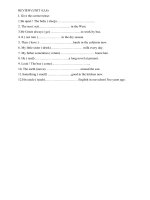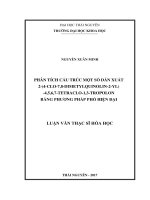report review chapter 4 5 6 1 basic probability concepts
Bạn đang xem bản rút gọn của tài liệu. Xem và tải ngay bản đầy đủ của tài liệu tại đây (1.17 MB, 16 trang )
<span class="text_page_counter">Trang 1</span><div class="page_container" data-page="1">
REPORT
REVIEW CHAPTER 4,5,6LECTURE: TON THAT QUOC TAN
HOANG LE YEN NHI
</div><span class="text_page_counter">Trang 2</span><div class="page_container" data-page="2">CHAPTER 4: BASIC PROBABILITY
4.1 Basic Probability Conceptsa.Events and sample spaces:
- Events are subsets of the sample space, the set of all outcomes that produce a specificresult.
- The complement of an event A, noted by the symbol A', is the subset of outcomes thatare not part of the event.
- A set of events are mutually exclusive if they cannot occur at the same.- A set of events are collectively exhaustive if one of the events must occur.
- A certain event is an event that is sure to occur such as “roll a value greater than 0” forrolling one fair die.
- An impossible event is an event that has no chance of occurring, such as “roll a valuegreater than 6” for rolling one fair die.
- Subjective probability, differs from the other two approaches because subjectiveprobability differs from person to person.
c.Summarizing Sample Spaces
- Sample space is all possible outcomes of an experiment.- The symbol (S) is used to for the sample space.d.Simple Probability
- Simple probability is the probability of occurrence of a simple event A, P(A) in which eachoutcome is equally likely to occur.
PROBABILITY OF OCCURRENCEProbability of occurrence = X/T
where X = number of outcomes in which the event occursT = total number of possible outcomes
</div><span class="text_page_counter">Trang 3</span><div class="page_container" data-page="3">EX: How can you determine the probability of selecting a household that planned to purchasea large TV? Using the Table summary table, you determine the value of X as 250, the totalof the Planned-to-Purchase Yes row and determine the value of T as 1,000, the overall total ofrespondents located in the lower right corner cell of the table.
- The marginal probability of an event consists of a set of joint probabilities. You candetermine the marginal probability of a particular event by using the concept of jointprobability just discussed.
MARGINAL PROBABILITY
P(A) = P(A and B1) + P(A and B2) +...+ P(A and Bk)
where B1, B2,..., Bk are k mutually exclusive and collectively exhaustive events.
EX:You can use Equation (4.2) to compute the marginal probability of “planned to purchase”a large TV:
P(Planned to purchase) = (Planned to purchase and purchased)+ PP (Planned to purchaseanddid not purchase)
=200/1,000 + 50/1,000 = 250/1,000= 0.25
You get the same result if you add the number of outcomes that make up the simple event
</div><span class="text_page_counter">Trang 4</span><div class="page_container" data-page="4">“planned to purchase.”g.General Addition Rule
-The probability of A or B is equal to the probability of A plus the probability of B minus theprobability of A and B.
P(A or B) = P(A) + P(B) - P(A and B)
-The general addition rule consists of taking the probability of A and adding it to theprobability of B and then subtracting the probability of the joint event A and B from this totalbecause the joint event has already been included in computing both the probability of A andthe probability of B.
EX:One way to calculate the probability of “planned to purchase or actually purchased” isP(Planned to purchase or actually purchased) = (Planned to purchase)+ (Actually purchased)P P- P(Planned to purchase and actually purchased)
For example Suppose you have two decks of playing cards, one with red backs and one withblue backs. The red deck contains 26 cards, including 13 spades and 13 hearts. The bluedeck contains 26 cards, including 13 clubs and 13 diamonds. You draw a card at randomfrom the red deck and see that it is a spade. What is the probability that the next card youdraw from the blue deck is a diamond?
To solve this problem, we need to use conditional probability. Let A be the event that the firstcard drawn is a spade from the red deck, and let B be the event that the second card drawnis a diamond from the blue deck. Then we want to find P(B|A), the probability of B given thatA has occurred.
Using the formula for conditional probability, we have:
</div><span class="text_page_counter">Trang 5</span><div class="page_container" data-page="5">P(B|A) = P(A and B) / P(A)
To find P(A and B), we can use the multiplication rule:P(A and B) = P(A) * P(B|A)
We know that P(A) is the probability of drawing a spade from the red deck, which is 13/26 or1/2. To find P(B|A), we need to calculate the probability of drawing a diamond from the bluedeck, given that we have already drawn a spade from the red deck. Since we have alreadydrawn one card, there are 51 cards remaining in the two decks, of which 25 are diamonds.Therefore:
P(B|A) = 25/51
Putting it all together, we have:
P(A and B) = P(A) * P(B|A) = (1/2) * (25/51) = 25/102And:
P(B|A) = P(A and B) / P(A) = (25/102) / (1/2) = 25/51
So the probability of drawing a diamond from the blue deck, given that we have alreadydrawn a spade from the red deck, is 25/51.
4.3 Ethical Issues and Probability:
Ethical issues can arise when any statements related to probability are presented to thepublic.
Unintended misinterpretations can occur with people who are not comfortable with numericalconcepts.
Advertising quoting probabilities can also be intentionally misleading.
4.4 . Bayes’ Theorem
Bayes’ theorem is an extension of what you previously learned about conditional probability.Bayes’ theorem revises previously calculated probabilities using additional information andforms the basis for Bayesian analysis.
- Bayes’ Theorem is used to revise previously calculated probabilities based on newinformation. It is an extension of conditional probability.
</div><span class="text_page_counter">Trang 6</span><div class="page_container" data-page="6">Ex:- One drilling company estimated a 40% chance of finding oil for their new well.A detailed test has been scheduled for more information. Previously, 60% of successful wells
were examined in detail and 20% of failed wells were examined in detail.Given that this well has been scheduled for a detailed inspection, what is the probability that
the well will be successful?Set S = good success
U = failed well
P(S) = 0.4 , P(U) = 0.6 (previous probability)Defining a detailed test event is EASY
Conditional Probability:P(D|S) = 0.6 P(D|U) = 0.2The goal is to find P(S|D)
</div><span class="text_page_counter">Trang 7</span><div class="page_container" data-page="7">Rules for counting the number of possible outcomesCounting Rule 1:
If any one of k different mutually exclusive and collectively exhaustive events can occuron each of n trials, the number of possible outcomes is equal to
Ex: You want to go to a park, eat at a restaurant, and see a movie. There are 3parks, 4 restaurants, and 6 movie choices. How many different possible combinations arethere?
Answer: (3)(4)(6) = 72 different possibilities
</div><span class="text_page_counter">Trang 8</span><div class="page_container" data-page="8">CHAP 5 :Discrete Probability Distributions
I. The Probability Distribution for a Discrete Variable- A probability distribution for a discrete variable is a mutually exclusive list of allpossible numerical outcomes for that variable and a probability of occurrenceassociated with each outcome.
1. Expected Value Of Discrete Variables
E(X) = Expected value of the discrete variable Xxi = the ith outcome of X
P(X=xi) = Probability of the ith occurrence of X
</div><span class="text_page_counter">Trang 9</span><div class="page_container" data-page="9">ProbabilityP(X = x )<small>i</small>
</div><span class="text_page_counter">Trang 10</span><div class="page_container" data-page="10">3 0.10 (3 – 1.4) =2.56
1. Properties of the Binomial Distribution- A fixed number of observations, n.
- e.g., 15 tosses of a coin; ten light bulbs taken from a warehouse.
- Each observation is classified into one of two mutually exclusive & collectivelyexhaustive categories.
- e.g., head or tail in each toss of a coin; defective or not defective light bulb.- The probability of being classified as the event of interest, π, is constant from
Ex: How many possible 3 scoop combinations could you create at an icecream parlor if you have 31 flavors to select from and no flavor can be used morethan once in the 3 scoops?
The total choices is n = 31, and we select X = 3.
</div><span class="text_page_counter">Trang 11</span><div class="page_container" data-page="11">P(X=x|n,π) = probability that X = x events of interest, given n and πx = number of “events of interest” in sample,
(x = 0, 1, 2, ..., n)
n = sample size (number of trialsor observations)π = probability of “event of interest”1 – π = probability of not having an
event of interest
Ex: Suppose in a casino a player bets $10 that there will be 6 heads out of 20tosses, the probability of a heads-up is 0.5. That player wants to calculate theprobability of this happening, so he uses the binomial distribution.
The probability of getting exactly 6 heads in 20 tosses is 0.037 or 3.7%. Sothis player made a bad bet.
Binomial Distribution Characteristics
The Poisson distribution is a discrete probability function which means that the variable canonly take specific values within a given list of numbers, possibly infinite.
The Poisson distribution measures the number of times an event is likely to occur in the "x"period. In other words, we can define it as the probability distribution that is the result of thePoisson experiment.
The Poisson test is a statistical test that classifies testing into two categories, such assuccess or failure. The Poisson distribution is a limiting process of the binomial distribution.The Poisson random variable “x” determines the number of successes in the experiment.This distribution occurs when there are events that do not occur as a result of certainoutcomes. The Poisson distribution is used under certain conditions. They are:
● The number of trials “n” tends to be infinite● The probability of success “p” tends to be zero● np = 1 is finite
</div><span class="text_page_counter">Trang 12</span><div class="page_container" data-page="12">CHAPTER 6
</div><span class="text_page_counter">Trang 13</span><div class="page_container" data-page="13">The normal distribution
The normal distribution is a continuous probability distribution shaped like a symmetric bellcurve. It is widely used in statistics to model natural phenomena such as height, weight, IQ,test scores, and many others. The normal distribution is characterized by two mainparameters, the mean and the standard deviation.
Any normal distribution (with any combination of mean and standard deviation) can beconverted to a normal (Z) distribution.
To calculate the normal probability, it is necessary to convert X units to Z units.The standard normal distribution (Z) has a mean of 0 and a standard deviation of 1.
</div><span class="text_page_counter">Trang 14</span><div class="page_container" data-page="14">If X is normally distributed with a mean of 100 and a standard deviation of 50, the Z value forX = 200 is:
This says that X = 200 is two standard deviations (2 increments of 50 units) above the meanof 100.
A normalized probability density function is a mathematical function that describes theprobability distribution of a normally distributed random variable with a mean of 0 and astandard deviation of 1.
The graph of the normal normalized probability density function is a bell curve that issymmetric around the mean (which is 0) and has a total area of one. The curve peaks at themean and decreases as the distance from the mean increases.
The normalized probability density function is useful in many areas of statistics andprobability theory because it allows for probability calculations involving normally distributedrandom variables. It is also used in statistical inference, hypothesis testing, and calculationof confidence intervals.x`
III. TheUniformDistributions
</div><span class="text_page_counter">Trang 15</span><div class="page_container" data-page="15">- Evenly distributed (uniform distribution) isaprobabilitydistributionofequal probability (equal probabilities) for all possible outcomes of therandomvariable
-IV.TheExponentialDistributions(exponentialdistribution)
</div><span class="text_page_counter">Trang 16</span><div class="page_container" data-page="16">- Usedtomodelthetimeintervalbetweentwooccurrencesofanevent- Forexample:timetimebetween2timeexportpresentlybelongtomoonreal
- Biến cố là tập con của không gian mẫu, tập hợp tất cả các kết cục tạo ra một kết quảxác định.vd:Tung một con xúc xắc là một phép thử, cịn việc lật lên mặt nào đó là biến
-Không gian mẫu là tập hợp tất cả các kết quả có thể có của một biến. vd: tung một conxúc xắc có sáu mặt thì, khơng gian mẫu là tập {1, 2, 3, 4, 5, 6}.
</div>








